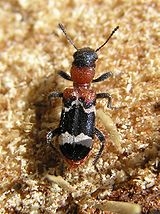
Cleridae
Encyclopedia
Cleridae are a family of beetle
s of the superfamily Cleroidea
. They are commonly known as checkered beetles. The Cleridae family has a worldwide distribution, and a variety of habitats and feeding preferences.
Cleridae have a large number of niche
s and feeding habits. Most genera are predaceous and feed on other beetles and larvae; however other genera are scavengers or pollen feeders. Clerids have elongated bodies with bristly hairs, are usually bright colored, and have variable antennae
. Checkered beetles range in length between 3 millimeters and 24 millimeters. Cleridae can be identified based on their 5–5–5 tarsal formula, division of sternites, and the absence of a special type of vesicle. Female Cleridae lay between 28–42 eggs at a time predominately under the bark of trees. Larvae are predaceous and feed vigorously before pupation and subsequently emergence as adults.
Clerids have a minor significance in forensic entomology
. Some species are occasionally found on carrion in the later dry stages of decay
. Also, some species are pests (stored product entomology) and are found infesting various food products. Research efforts related to Cleridae have focused primarily on using certain species as biological controls. This is a very effective technique for controlling bark beetle
s due to the voracious appetite of many Clerid species.
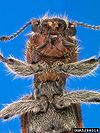
in shape and range from 3–24 millimeters (.1–1 in). Their entire bodies are covered with bristly hairs, and many display an ornate body color pattern. These often brightly color patterns can be red, yellow, orange, or blue. The antennae are clubbed at the tip for most species, but others can be “clubbed, saw-tooth, or thread-like.” The pronotum region is nearly cylindrical and characteristically narrower than the elytra (special hardened front wings), while the head is as wide or wider than the pronotum
. Their elytra have tiny pits or depressions, and never expose more than two tergites (dorsal
plates).
. Key characteristics of Polyphaga are that the hind coxa
(base of the leg), do not divide the first and second abdominal/ventral plates which are known as sternites. Also, the notopleural
suture (found under the pronotal shield) is not present. To further identify Clerid beetles, a few additional characteristics need to be examined.
 Clerid beetles have unique legs that help to distinguish them from other families. Their tarsal
Clerid beetles have unique legs that help to distinguish them from other families. Their tarsal
formula is 5–5–5, meaning that on each of the front, middle and hind legs there are 5 tarsomeres (individual subsegments of the feet/tarsi). One or more of these subsegments on each leg is typically lobed, and the 4th tarsi is normally difficult to distinguigh. Furthermore, an important feature that eliminates many other families of beetles is that Clerids' front coxae (base of the leg) expose the second segment of the legs known as the trochanter.
The second defining characteristic of the Cleridae family is that Clerids never have eversible vesicles (small usually hidden balloon-like structures thought to be scent glands) on their abdomen
and pronotum. This characteristic distinguishes them from a similar family Melyridae
which sometimes has these glands. This trait is very important in correctly differentiating checkered beetles from Melyridae.
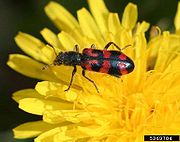 Cleridae can be found in the Americas, Africa, Europe, the Middle East and even in Australia. There are approximately 3,500 species in the world and about 500 species in North America. Due to this wide distribution there are many different habitats in which the checkered beetles can be found.
Cleridae can be found in the Americas, Africa, Europe, the Middle East and even in Australia. There are approximately 3,500 species in the world and about 500 species in North America. Due to this wide distribution there are many different habitats in which the checkered beetles can be found.
Many of the species are known as "flower visitors", that prey on other flower
visiting insects and also feed on pollen
. These species are found in moist, sunny environments where flowering plants are found in abundance.
Another habitat commonly inhabited by beetles in the Cleridae family is trees. These "tree living species" are found in forests across the world with various climates and an array of easily preyed upon insects. They seek protection under the bark and hunt for other insects above and below the bark
. The primary source of prey for these bark living hunters is bark beetles.
The third type of clerid beetles is the "nest robbing species" which live in shrubbery and in trees. Unlike the tree living species these species do not actually burrow
into the bark. Nest robbing species typically hunt termite, bee, and wasp larvae, and one particular species has been noted to prey primarily on grasshopper egg masses. Not all nest robbing species actively hunt live prey, some species for example prefer to feed only on dead honey bee larvae and adults.
In general, the bulk of adult Cleridae feed mainly on other adult beetles while the larvae stage feed on other beetle larvae. Some checkered beetles are known to have an extremely voracious appetite with some larvae able to consume "several times their own body weight” in a day.
Although most species of checkered beetles are predaceous in nature, some are scavengers and others have been found feeding on flower pollen. Because of the checkered beetles predaceous nature and insatiable appetite, they are often key players in the biological control of other insects. The checkered beetles have also developed a unique adaptation to aid in their quest for prey. The beetles use pheromones to help them locate, kill, and consume their prey.
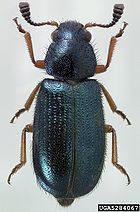 The diversity of checkered beetle's feeding habits is quite evident when different species are examined. The Necrobia spp.
The diversity of checkered beetle's feeding habits is quite evident when different species are examined. The Necrobia spp.
are attracted to dry carrion and other decomposing animal matter such as bones and skin as well as various meat products. Thanasimus spp. are found in woodland
areas where bark beetle species constitute their main source of prey. The primary source of prey for the Phyllobaenus spp. are wood borers, immature weevils, and hymenoptera
larvae. One of the more diverse genera
is Trichodes, the larvae feed on the pollen of flowering plants and adults prey upon grasshoppers and wasps.
development. A majority of the known Cleridae species larvae feed upon the eggs and young of wood-boring beetles, while the adults feed on the adult bark beetles.
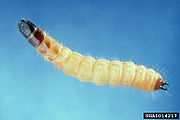 Copulation takes place while the female feeds, because females need a large amount of food for egg development. The female lays her eggs 36–72 hours after copulation. The eggs are laid in between pieces of bark on wood-borer-infested trees or under stones in the soil. She may lay 28–42 eggs at a time. For the longer lifespaned species such as the Thanasimus sp. this occurs in late summer
Copulation takes place while the female feeds, because females need a large amount of food for egg development. The female lays her eggs 36–72 hours after copulation. The eggs are laid in between pieces of bark on wood-borer-infested trees or under stones in the soil. She may lay 28–42 eggs at a time. For the longer lifespaned species such as the Thanasimus sp. this occurs in late summer
or early fall to give the larva
e enough time for proper growth before having to overwinter
.
When larvae hatch from their eggs, they are either red or yellow. Their bodies have a slender and flat appearance with short legs due to their minimal movement. The larvae are covered in hair and have two horn-type projections on the dorsal
area of the last body segment. Immediately after birth, they start searching for food close to where they hatched. They feed on wood-borer insects on trees, or feed on their species' substrate or prey of choice. Feeding is the main purpose of the larval stage to prepare for pupation. Once their larval stage is complete the tree dwelling species make their way to the bottom of the tree to pupate. The pupa
l stage can last from 6 weeks to one year depending on the need to overwinter, and how short the overall lifecycle is for a particular species. A majority of Cleridae species pupate in earthen cells which are made from soil and certain enzymes secreted from their mouths. The rest remain in pupal cells. Adult beetles emerge from pupation and spend a variable time of their life maturing, and eventually oviposit
. Sexually mature adults or imago
s of Thanasiumus sp. overwinter inside the wood-borer-infested trees and oviposit during the spring
.
, commonly known as the red-legged ham beetle, is of particular importance in stored product entomology. N. rufipes infests dried
or smoked meats, especially those products that are stored unwrapped for long periods of time. Adults feed on the surface of the products, while the larvae damage the meat by boring down usually in the fatty parts. N. rufipes has been recorded to have fed upon a large variety of items ranging from hides and dried figs to Egyptian mummies. In addition, products such as wool
and silk
can become infested, but not destroyed.
. Most members of the Cleridae family are not useful in forensics
because of their food choice, but some species such as the Necrobia rufipes can be useful. Necrobia rufipes is attracted towards carrion in the later stages of decomposition, so its arrival on carrion can help provide an estimate for the post-mortem interval or PMI. Although the checkered beetle is not the most significant insect on carrion, the beetles predaceous nature and its ability to reproduce in carrion that is exposed to the environment provides some forensic importance.
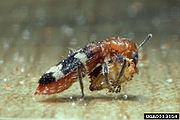
or IPM. Thanasimus undatulus is a predator of bark beetles. Some species of bark beetles such as the southern pine beetle and the mountain pine beetle
can become pests to the lumber
industry because in large numbers they can cause damage and kill live trees. Thanasimus undatulus has been researched as a possible biological control agent for these pests. Researchers and forestry officials have used bark beetle aggreagation pheromones to attract the checkered beetle to specific trees. This causes the bark beetles to be overwhelmed, extensively preyed upon by the Clerid beetles, and typically eliminated.
There is also additional research being done pertaining to the impact of Cleridae beetles on pollination in flowers.
of Cleridae are divided among several subfamilies, though some genera still defy easy classification. Several taxonomic schemes exist, recognizing for example a group around Neorthopleura as distinct subfamily Neorthopleurinae, or splitting off the Thaneroclerinae as distinct family, or circumscribing the Korynetinae sensu stricto or sensu lato. The following list of tribes and selected genera is thus preliminary. Some notable species are also listed.
Beetle
Coleoptera is an order of insects commonly called beetles. The word "coleoptera" is from the Greek , koleos, "sheath"; and , pteron, "wing", thus "sheathed wing". Coleoptera contains more species than any other order, constituting almost 25% of all known life-forms...
s of the superfamily Cleroidea
Cleroidea
Cleroidea is a small superfamily of beetles. Most of the members of the group are somewhat slender, often with fairly soft, flexible elytra, and typically hairy or scaly.It contains about 10,000 species in the families:* Acanthocnemidae Crowson 1964...
. They are commonly known as checkered beetles. The Cleridae family has a worldwide distribution, and a variety of habitats and feeding preferences.
Cleridae have a large number of niche
Niche
Niche may refer to:*Niche , an exedra or an apse that has been reduced in size;*Niche , Colombian/Spanish football player, full name Víctor Manuel Micolta Armero*Niche , a British Thoroughbred racehorse...
s and feeding habits. Most genera are predaceous and feed on other beetles and larvae; however other genera are scavengers or pollen feeders. Clerids have elongated bodies with bristly hairs, are usually bright colored, and have variable antennae
Antenna (biology)
Antennae in biology have historically been paired appendages used for sensing in arthropods. More recently, the term has also been applied to cilium structures present in most cell types of eukaryotes....
. Checkered beetles range in length between 3 millimeters and 24 millimeters. Cleridae can be identified based on their 5–5–5 tarsal formula, division of sternites, and the absence of a special type of vesicle. Female Cleridae lay between 28–42 eggs at a time predominately under the bark of trees. Larvae are predaceous and feed vigorously before pupation and subsequently emergence as adults.
Clerids have a minor significance in forensic entomology
Forensic entomology
Forensic entomology is the application and study of insect and other arthropod biology to criminal matters. It is primarily associated with death investigations; however, it may also be used to detect drugs and poisons, determine the location of an incident, and find the presence and time of the...
. Some species are occasionally found on carrion in the later dry stages of decay
Decomposition
Decomposition is the process by which organic material is broken down into simpler forms of matter. The process is essential for recycling the finite matter that occupies physical space in the biome. Bodies of living organisms begin to decompose shortly after death...
. Also, some species are pests (stored product entomology) and are found infesting various food products. Research efforts related to Cleridae have focused primarily on using certain species as biological controls. This is a very effective technique for controlling bark beetle
Bark beetle
A bark beetle is one of approximately 220 genera with 6,000 species of beetles in the subfamily Scolytinae. Traditionally, this was considered a distinct family Scolytidae, but now it is understood that bark beetles are in fact very specialized members of the "true weevil" family...
s due to the voracious appetite of many Clerid species.
Physical description

Appearance
Generally, checkered beetles are elongated and ovalOval
An oval is any curve resembling an egg or an ellipse, such as a Cassini oval. The term does not have a precise mathematical definition except in one area oval , but it may also refer to:* A sporting arena of oval shape** a cricket field...
in shape and range from 3–24 millimeters (.1–1 in). Their entire bodies are covered with bristly hairs, and many display an ornate body color pattern. These often brightly color patterns can be red, yellow, orange, or blue. The antennae are clubbed at the tip for most species, but others can be “clubbed, saw-tooth, or thread-like.” The pronotum region is nearly cylindrical and characteristically narrower than the elytra (special hardened front wings), while the head is as wide or wider than the pronotum
Prothorax
The prothorax is the foremost of the three segments in the thorax of an insect, and bears the first pair of legs. Its principal sclerites are the pronotum , the prosternum , and the propleuron on each side. The prothorax never bears wings in extant insects, though some fossil groups possessed...
. Their elytra have tiny pits or depressions, and never expose more than two tergites (dorsal
Dorsum (biology)
In anatomy, the dorsum is the upper side of animals that typically run, fly, or swim in a horizontal position, and the back side of animals that walk upright. In vertebrates the dorsum contains the backbone. The term dorsal refers to anatomical structures that are either situated toward or grow...
plates).
Identification
Clerid beetles fall under the suborder PolyphagaPolyphaga
Polyphaga is the largest and most diverse suborder of beetles; the name is derived from two two Greek words: poly-, meaning 'many', and phagein, meaning 'to eat', so the suborder is called the “eaters of many things”...
. Key characteristics of Polyphaga are that the hind coxa
Coxa
Coxa may refer to:* Theta Leonis, a star* Nickname of Brazilian soccer team Coritiba Foot Ball Club* Hip, below the lateral side of the abdomen* The short most-proximal base jointed segment of the arthropod leg...
(base of the leg), do not divide the first and second abdominal/ventral plates which are known as sternites. Also, the notopleural
Notopleuron
The notopleuron is a region on an insect thorax. They are used in characterizing species, particularly in the Family Diptera . The notopleuron is a thoracic pleurite situated at the end of the transverse suture of Diptera.-References:* Zombori, L...
suture (found under the pronotal shield) is not present. To further identify Clerid beetles, a few additional characteristics need to be examined.

Arthropod leg
The arthropod leg is a form of jointed appendage of arthropods, usually used for walking. Many of the terms used for arthropod leg segments are of Latin origin, and may be confused with terms for bones: coxa , trochanter , femur, tibia, tarsus, ischium, metatarsus, carpus, dactylus ,...
formula is 5–5–5, meaning that on each of the front, middle and hind legs there are 5 tarsomeres (individual subsegments of the feet/tarsi). One or more of these subsegments on each leg is typically lobed, and the 4th tarsi is normally difficult to distinguigh. Furthermore, an important feature that eliminates many other families of beetles is that Clerids' front coxae (base of the leg) expose the second segment of the legs known as the trochanter.
The second defining characteristic of the Cleridae family is that Clerids never have eversible vesicles (small usually hidden balloon-like structures thought to be scent glands) on their abdomen
Abdomen
In vertebrates such as mammals the abdomen constitutes the part of the body between the thorax and pelvis. The region enclosed by the abdomen is termed the abdominal cavity...
and pronotum. This characteristic distinguishes them from a similar family Melyridae
Melyridae
Melyridae are a family of beetles of the superfamily Cleroidea. The family Melyridae contains 520 species in 58 genera in North America. Most are elongate-oval, soft-bodied beetles 10 mm long or less. Many are brightly colored with brown or red and black...
which sometimes has these glands. This trait is very important in correctly differentiating checkered beetles from Melyridae.
Distribution and ecology

Many of the species are known as "flower visitors", that prey on other flower
Flower
A flower, sometimes known as a bloom or blossom, is the reproductive structure found in flowering plants . The biological function of a flower is to effect reproduction, usually by providing a mechanism for the union of sperm with eggs...
visiting insects and also feed on pollen
Pollen
Pollen is a fine to coarse powder containing the microgametophytes of seed plants, which produce the male gametes . Pollen grains have a hard coat that protects the sperm cells during the process of their movement from the stamens to the pistil of flowering plants or from the male cone to the...
. These species are found in moist, sunny environments where flowering plants are found in abundance.
Another habitat commonly inhabited by beetles in the Cleridae family is trees. These "tree living species" are found in forests across the world with various climates and an array of easily preyed upon insects. They seek protection under the bark and hunt for other insects above and below the bark
Bark
Bark is the outermost layers of stems and roots of woody plants. Plants with bark include trees, woody vines and shrubs. Bark refers to all the tissues outside of the vascular cambium and is a nontechnical term. It overlays the wood and consists of the inner bark and the outer bark. The inner...
. The primary source of prey for these bark living hunters is bark beetles.
The third type of clerid beetles is the "nest robbing species" which live in shrubbery and in trees. Unlike the tree living species these species do not actually burrow
Burrow
A burrow is a hole or tunnel dug into the ground by an animal to create a space suitable for habitation, temporary refuge, or as a byproduct of locomotion. Burrows provide a form of shelter against predation and exposure to the elements, so the burrowing way of life is quite popular among the...
into the bark. Nest robbing species typically hunt termite, bee, and wasp larvae, and one particular species has been noted to prey primarily on grasshopper egg masses. Not all nest robbing species actively hunt live prey, some species for example prefer to feed only on dead honey bee larvae and adults.
Feeding habits
The Cleridae family contains many species of predaceous beetles that feed on other beetles and beetle larvae in their natural habitat. The most common prey item for checkered beetles are the bark beetles and wood boring beetles.In general, the bulk of adult Cleridae feed mainly on other adult beetles while the larvae stage feed on other beetle larvae. Some checkered beetles are known to have an extremely voracious appetite with some larvae able to consume "several times their own body weight” in a day.
Although most species of checkered beetles are predaceous in nature, some are scavengers and others have been found feeding on flower pollen. Because of the checkered beetles predaceous nature and insatiable appetite, they are often key players in the biological control of other insects. The checkered beetles have also developed a unique adaptation to aid in their quest for prey. The beetles use pheromones to help them locate, kill, and consume their prey.

Species
In biology, a species is one of the basic units of biological classification and a taxonomic rank. A species is often defined as a group of organisms capable of interbreeding and producing fertile offspring. While in many cases this definition is adequate, more precise or differing measures are...
are attracted to dry carrion and other decomposing animal matter such as bones and skin as well as various meat products. Thanasimus spp. are found in woodland
Woodland
Ecologically, a woodland is a low-density forest forming open habitats with plenty of sunlight and limited shade. Woodlands may support an understory of shrubs and herbaceous plants including grasses. Woodland may form a transition to shrubland under drier conditions or during early stages of...
areas where bark beetle species constitute their main source of prey. The primary source of prey for the Phyllobaenus spp. are wood borers, immature weevils, and hymenoptera
Hymenoptera
Hymenoptera is one of the largest orders of insects, comprising the sawflies, wasps, bees and ants. There are over 130,000 recognized species, with many more remaining to be described. The name refers to the heavy wings of the insects, and is derived from the Ancient Greek ὑμήν : membrane and...
larvae. One of the more diverse genera
Genera
Genera is a commercial operating system and development environment for Lisp machines developed by Symbolics. It is essentially a fork of an earlier operating system originating on the MIT AI Lab's Lisp machines which Symbolics had used in common with LMI and Texas Instruments...
is Trichodes, the larvae feed on the pollen of flowering plants and adults prey upon grasshoppers and wasps.
Life cycle
The general life cycle of clerids has been known to last anywhere from 35 days to more than 3 years, and is strongly dependent on the life cycle of their prey. While the life cycle can vary in length between genus and species, temperature is also a major determinant in the length of time spent in each stage of development. The warmer the temperature is, the quicker the lifecycle, and the cooler the temperature is the slower the lifecycle. If temperatures dip below a threshold temperature for an extended period of time Clerids and most other insects will have growth and developmental progress arrested. Cleridae exhibit a holometablolousHolometabolism
Holometabolism, also called complete metamorphism, is a term applied to insect groups to describe the specific kind of insect development which includes four life stages - as an embryo or egg, a larva, a pupa and an imago or adult. Holometabolism is a monophyletic trait that all insects in the...
development. A majority of the known Cleridae species larvae feed upon the eggs and young of wood-boring beetles, while the adults feed on the adult bark beetles.

Summer
Summer is the warmest of the four temperate seasons, between spring and autumn. At the summer solstice, the days are longest and the nights are shortest, with day-length decreasing as the season progresses after the solstice...
or early fall to give the larva
Larva
A larva is a distinct juvenile form many animals undergo before metamorphosis into adults. Animals with indirect development such as insects, amphibians, or cnidarians typically have a larval phase of their life cycle...
e enough time for proper growth before having to overwinter
Overwinter
To overwinter is to pass through or wait out the winter season, or to pass through that period of the year when “winter” conditions make normal activity or even survival difficult or near impossible...
.
When larvae hatch from their eggs, they are either red or yellow. Their bodies have a slender and flat appearance with short legs due to their minimal movement. The larvae are covered in hair and have two horn-type projections on the dorsal
Dorsum (biology)
In anatomy, the dorsum is the upper side of animals that typically run, fly, or swim in a horizontal position, and the back side of animals that walk upright. In vertebrates the dorsum contains the backbone. The term dorsal refers to anatomical structures that are either situated toward or grow...
area of the last body segment. Immediately after birth, they start searching for food close to where they hatched. They feed on wood-borer insects on trees, or feed on their species' substrate or prey of choice. Feeding is the main purpose of the larval stage to prepare for pupation. Once their larval stage is complete the tree dwelling species make their way to the bottom of the tree to pupate. The pupa
Pupa
A pupa is the life stage of some insects undergoing transformation. The pupal stage is found only in holometabolous insects, those that undergo a complete metamorphosis, going through four life stages; embryo, larva, pupa and imago...
l stage can last from 6 weeks to one year depending on the need to overwinter, and how short the overall lifecycle is for a particular species. A majority of Cleridae species pupate in earthen cells which are made from soil and certain enzymes secreted from their mouths. The rest remain in pupal cells. Adult beetles emerge from pupation and spend a variable time of their life maturing, and eventually oviposit
Oviposition
Oviposition is the process of laying eggs by oviparous animals.Some arthropods, for example, lay their eggs with an organ called the ovipositor.Fish , amphibians, reptiles, birds and monetremata also lay eggs....
. Sexually mature adults or imago
Imago
In biology, the imago is the last stage of development of an insect, after the last ecdysis of an incomplete metamorphosis, or after emergence from the pupa where the metamorphosis is complete...
s of Thanasiumus sp. overwinter inside the wood-borer-infested trees and oviposit during the spring
Spring (season)
Spring is one of the four temperate seasons, the transition period between winter and summer. Spring and "springtime" refer to the season, and broadly to ideas of rebirth, renewal and regrowth. The specific definition of the exact timing of "spring" varies according to local climate, cultures and...
.
Stored product entomology
Necrobia rufipesNecrobia rufipes
The red-legged ham beetle, Necrobia rufipes is a predatory beetle in the family Cleridae with a cosmopolitan distribution.The adult beetles are long, convex, straight sided, and the surface has indentations called punctures....
, commonly known as the red-legged ham beetle, is of particular importance in stored product entomology. N. rufipes infests dried
Dried meat
Dried meat is a feature of many cuisines around the world. Examples include:* Bakkwa or rougan a Chinese salty-sweet dried meat product made in the form of flat thin sheets* Biltong, a kind of cured meat that originated in South Africa...
or smoked meats, especially those products that are stored unwrapped for long periods of time. Adults feed on the surface of the products, while the larvae damage the meat by boring down usually in the fatty parts. N. rufipes has been recorded to have fed upon a large variety of items ranging from hides and dried figs to Egyptian mummies. In addition, products such as wool
Wool
Wool is the textile fiber obtained from sheep and certain other animals, including cashmere from goats, mohair from goats, qiviut from muskoxen, vicuña, alpaca, camel from animals in the camel family, and angora from rabbits....
and silk
Silk
Silk is a natural protein fiber, some forms of which can be woven into textiles. The best-known type of silk is obtained from the cocoons of the larvae of the mulberry silkworm Bombyx mori reared in captivity...
can become infested, but not destroyed.
Medico-legal entomology
Since Clerids are predaceous in nature, they have been found feeding on fly larvae as well as the skin and bones of carrionCarrion
Carrion refers to the carcass of a dead animal. Carrion is an important food source for large carnivores and omnivores in most ecosystems. Examples of carrion-eaters include vultures, hawks, eagles, hyenas, Virginia Opossum, Tasmanian Devils, coyotes, Komodo dragons, and burying beetles...
. Most members of the Cleridae family are not useful in forensics
Forensics
Forensic science is the application of a broad spectrum of sciences to answer questions of interest to a legal system. This may be in relation to a crime or a civil action...
because of their food choice, but some species such as the Necrobia rufipes can be useful. Necrobia rufipes is attracted towards carrion in the later stages of decomposition, so its arrival on carrion can help provide an estimate for the post-mortem interval or PMI. Although the checkered beetle is not the most significant insect on carrion, the beetles predaceous nature and its ability to reproduce in carrion that is exposed to the environment provides some forensic importance.

Ongoing research
There is ongoing research with some of the members of the Cleridae family. Forensic research is limited because of their late arrival on carrion, but members such as Thanasimus undatulus have been researched as a possible role in integrated pest managementIntegrated Pest Management
Integrated pest management is an ecological approach to agricultural pest control that integrates pesticides/herbicides into a management system incorporating a range of practices for economic control of a pest...
or IPM. Thanasimus undatulus is a predator of bark beetles. Some species of bark beetles such as the southern pine beetle and the mountain pine beetle
Mountain pine beetle
The mountain pine beetle Dendroctonus ponderosae, is a species of bark beetle native to the forests of western North America from Mexico to central British Columbia. It has a hard black exoskeleton, and measures about 5 millimeters, about the size of a grain of rice.Mountain pine beetles inhabit...
can become pests to the lumber
Lumber
Lumber or timber is wood in any of its stages from felling through readiness for use as structural material for construction, or wood pulp for paper production....
industry because in large numbers they can cause damage and kill live trees. Thanasimus undatulus has been researched as a possible biological control agent for these pests. Researchers and forestry officials have used bark beetle aggreagation pheromones to attract the checkered beetle to specific trees. This causes the bark beetles to be overwhelmed, extensively preyed upon by the Clerid beetles, and typically eliminated.
There is also additional research being done pertaining to the impact of Cleridae beetles on pollination in flowers.
Systematics
The generaGenera
Genera is a commercial operating system and development environment for Lisp machines developed by Symbolics. It is essentially a fork of an earlier operating system originating on the MIT AI Lab's Lisp machines which Symbolics had used in common with LMI and Texas Instruments...
of Cleridae are divided among several subfamilies, though some genera still defy easy classification. Several taxonomic schemes exist, recognizing for example a group around Neorthopleura as distinct subfamily Neorthopleurinae, or splitting off the Thaneroclerinae as distinct family, or circumscribing the Korynetinae sensu stricto or sensu lato. The following list of tribes and selected genera is thus preliminary. Some notable species are also listed.

